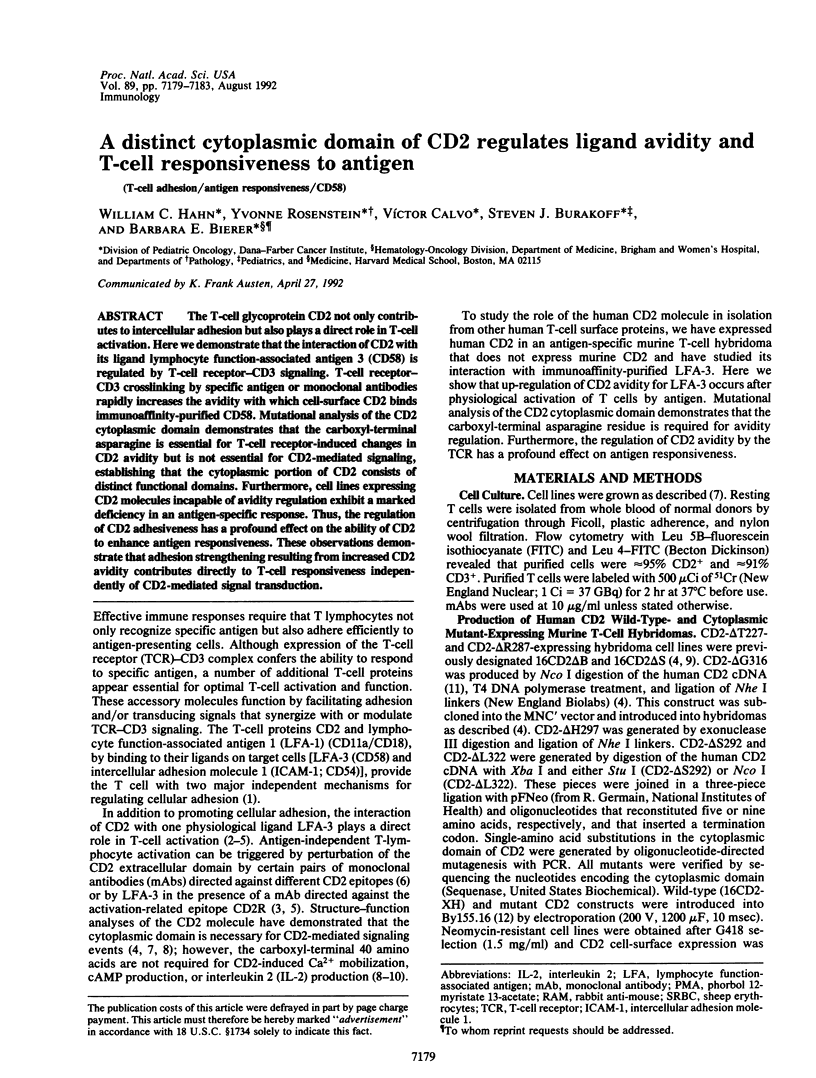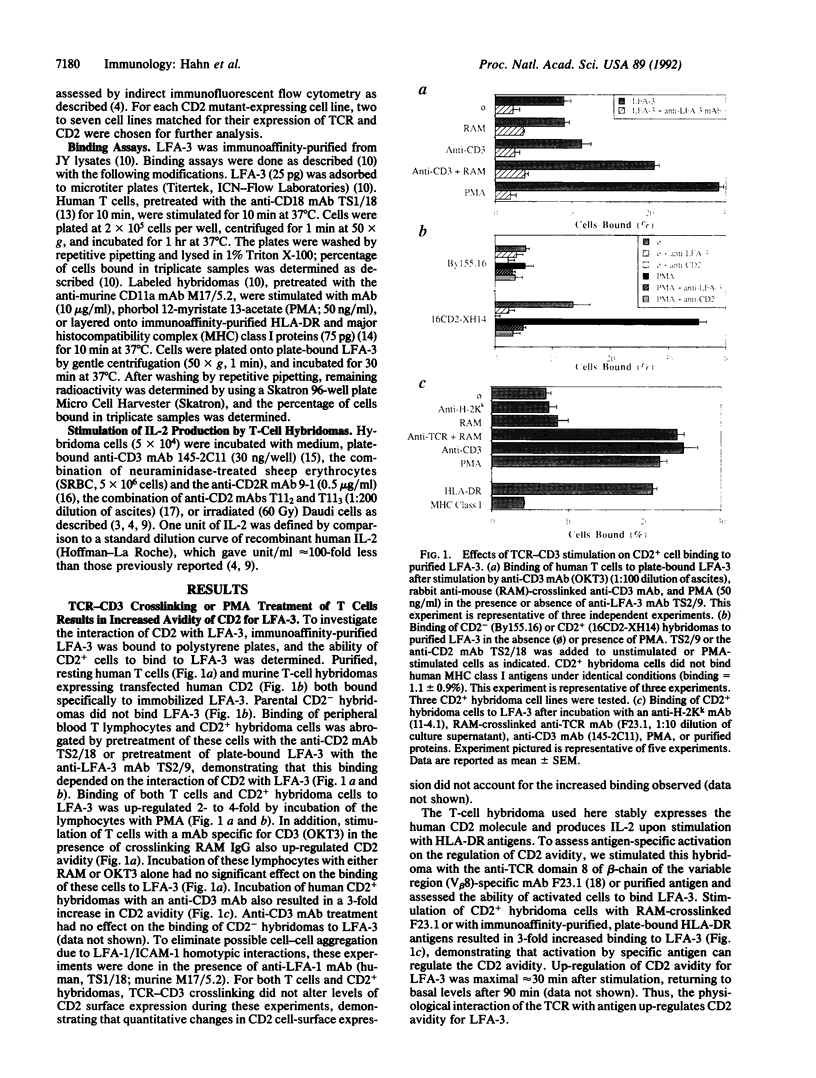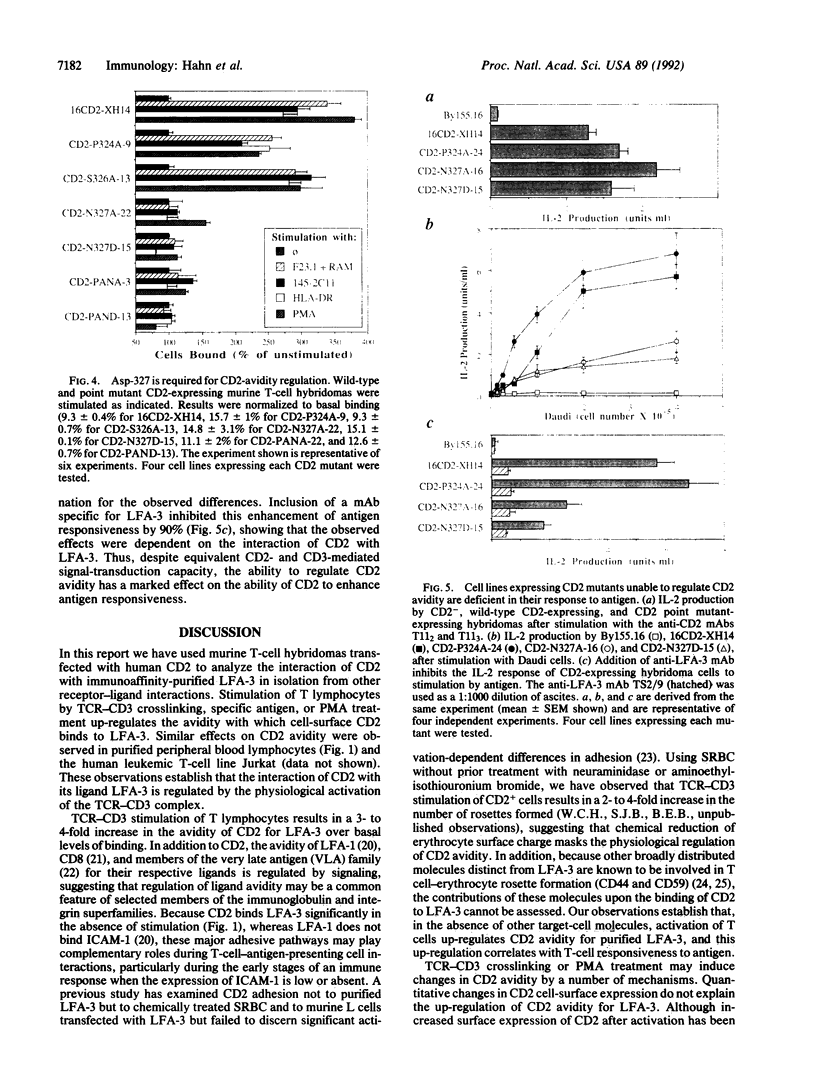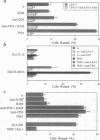Abstract
The T-cell glycoprotein CD2 not only contributes to intercellular adhesion but also plays a direct role in T-cell activation. Here we demonstrate that the interaction of CD2 with its ligand lymphocyte function-associated antigen 3 (CD58) is regulated by T-cell receptor-CD3 signaling. T-cell receptor-CD3 crosslinking by specific antigen or monoclonal antibodies rapidly increases the avidity with which cell-surface CD2 binds immunoaffinity-purified CD58. Mutational analysis of the CD2 cytoplasmic domain demonstrates that the carboxyl-terminal asparagine is essential for T-cell receptor-induced changes in CD2 avidity but is not essential for CD2-mediated signaling, establishing that the cytoplasmic portion of CD2 consists of distinct functional domains. Furthermore, cell lines expressing CD2 molecules incapable of avidity regulation exhibit a marked deficiency in an antigen-specific response. Thus, the regulation of CD2 adhesiveness has a profound effect on the ability of CD2 to enhance antigen responsiveness. These observations demonstrate that adhesion strengthening resulting from increased CD2 avidity contributes directly to T-cell responsiveness independently of CD2-mediated signal transduction.
Full text
PDF




Images in this article
Selected References
These references are in PubMed. This may not be the complete list of references from this article.
- Alberola-Ila J., Places L., de la Calle O., Romero M., Yagüe J., Gallart T., Vives J., Lozano F. Stimulation through the TCR/CD3 complex up-regulates the CD2 surface expression on human T lymphocytes. J Immunol. 1991 Feb 15;146(4):1085–1092. [PubMed] [Google Scholar]
- Bernard A., Knowles R. W., Naito K., Dupont B., Raynal B., Tran H. C., Boumsell L. A unique epitope on the CD2 molecule defined by the monoclonal antibody 9-1: epitope-specific modulation of the E-rosette receptor and effects on T-cell functions. Hum Immunol. 1986 Dec;17(4):388–405. doi: 10.1016/0198-8859(86)90299-5. [DOI] [PubMed] [Google Scholar]
- Bernard A., Tran H. C., Boumsell L. Three different erythrocyte surface molecules are required for spontaneous T cell rosette formation. J Immunol. 1987 Jul 1;139(1):18–23. [PubMed] [Google Scholar]
- Bierer B. E., Bogart R. E., Burakoff S. J. Partial deletions of the cytoplasmic domain of CD2 result in a partial defect in signal transduction. J Immunol. 1990 Feb 1;144(3):785–789. [PubMed] [Google Scholar]
- Bierer B. E., Peterson A., Barbosa J., Seed B., Burakoff S. J. Expression of the T-cell surface molecule CD2 and an epitope-loss CD2 mutant to define the role of lymphocyte function-associated antigen 3 (LFA-3) in T-cell activation. Proc Natl Acad Sci U S A. 1988 Feb;85(4):1194–1198. doi: 10.1073/pnas.85.4.1194. [DOI] [PMC free article] [PubMed] [Google Scholar]
- Bierer B. E., Peterson A., Gorga J. C., Herrmann S. H., Burakoff S. J. Synergistic T cell activation via the physiological ligands for CD2 and the T cell receptor. J Exp Med. 1988 Sep 1;168(3):1145–1156. doi: 10.1084/jem.168.3.1145. [DOI] [PMC free article] [PubMed] [Google Scholar]
- Chang H. C., Moingeon P., Lopez P., Krasnow H., Stebbins C., Reinherz E. L. Dissection of the human CD2 intracellular domain. Identification of a segment required for signal transduction and interleukin 2 production. J Exp Med. 1989 Jun 1;169(6):2073–2083. doi: 10.1084/jem.169.6.2073. [DOI] [PMC free article] [PubMed] [Google Scholar]
- Dustin M. L., Springer T. A. T-cell receptor cross-linking transiently stimulates adhesiveness through LFA-1. Nature. 1989 Oct 19;341(6243):619–624. doi: 10.1038/341619a0. [DOI] [PubMed] [Google Scholar]
- Hahn W. C., Menu E., Bothwell A. L., Sims P. J., Bierer B. E. Overlapping but nonidentical binding sites on CD2 for CD58 and a second ligand CD59. Science. 1992 Jun 26;256(5065):1805–1807. doi: 10.1126/science.1377404. [DOI] [PubMed] [Google Scholar]
- Hahn W. C., Rosenstein Y., Burakoff S. J., Bierer B. E. Interaction of CD2 with its ligand lymphocyte function-associated antigen-3 induces adenosine 3',5'-cyclic monophosphate production in T lymphocytes. J Immunol. 1991 Jul 1;147(1):14–21. [PubMed] [Google Scholar]
- He Q., Beyers A. D., Barclay A. N., Williams A. F. A role in transmembrane signaling for the cytoplasmic domain of the CD2 T lymphocyte surface antigen. Cell. 1988 Sep 23;54(7):979–984. doi: 10.1016/0092-8674(88)90112-2. [DOI] [PubMed] [Google Scholar]
- Hibbs M. L., Jakes S., Stacker S. A., Wallace R. W., Springer T. A. The cytoplasmic domain of the integrin lymphocyte function-associated antigen 1 beta subunit: sites required for binding to intercellular adhesion molecule 1 and the phorbol ester-stimulated phosphorylation site. J Exp Med. 1991 Nov 1;174(5):1227–1238. doi: 10.1084/jem.174.5.1227. [DOI] [PMC free article] [PubMed] [Google Scholar]
- Hünig T., Tiefenthaler G., Meyer zum Büschenfelde K. H., Meuer S. C. Alternative pathway activation of T cells by binding of CD2 to its cell-surface ligand. Nature. 1987 Mar 19;326(6110):298–301. doi: 10.1038/326298a0. [DOI] [PubMed] [Google Scholar]
- Koyasu S., Lawton T., Novick D., Recny M. A., Siliciano R. F., Wallner B. P., Reinherz E. L. Role of interaction of CD2 molecules with lymphocyte function-associated antigen 3 in T-cell recognition of nominal antigen. Proc Natl Acad Sci U S A. 1990 Apr;87(7):2603–2607. doi: 10.1073/pnas.87.7.2603. [DOI] [PMC free article] [PubMed] [Google Scholar]
- Leo O., Foo M., Sachs D. H., Samelson L. E., Bluestone J. A. Identification of a monoclonal antibody specific for a murine T3 polypeptide. Proc Natl Acad Sci U S A. 1987 Mar;84(5):1374–1378. doi: 10.1073/pnas.84.5.1374. [DOI] [PMC free article] [PubMed] [Google Scholar]
- Meuer S. C., Hussey R. E., Fabbi M., Fox D., Acuto O., Fitzgerald K. A., Hodgdon J. C., Protentis J. P., Schlossman S. F., Reinherz E. L. An alternative pathway of T-cell activation: a functional role for the 50 kd T11 sheep erythrocyte receptor protein. Cell. 1984 Apr;36(4):897–906. doi: 10.1016/0092-8674(84)90039-4. [DOI] [PubMed] [Google Scholar]
- Moingeon P. E., Lucich J. L., Stebbins C. C., Recny M. A., Wallner B. P., Koyasu S., Reinherz E. L. Complementary roles for CD2 and LFA-1 adhesion pathways during T cell activation. Eur J Immunol. 1991 Mar;21(3):605–610. doi: 10.1002/eji.1830210311. [DOI] [PubMed] [Google Scholar]
- Moingeon P., Chang H. C., Wallner B. P., Stebbins C., Frey A. Z., Reinherz E. L. CD2-mediated adhesion facilitates T lymphocyte antigen recognition function. Nature. 1989 May 25;339(6222):312–314. doi: 10.1038/339312a0. [DOI] [PubMed] [Google Scholar]
- O'Rourke A. M., Rogers J., Mescher M. F. Activated CD8 binding to class I protein mediated by the T-cell receptor results in signalling. Nature. 1990 Jul 12;346(6280):187–189. doi: 10.1038/346187a0. [DOI] [PubMed] [Google Scholar]
- Rosenstein Y., Burakoff S. J., Herrmann S. H. HIV-gp120 can block CD4-class II MHC-mediated adhesion. J Immunol. 1990 Jan 15;144(2):526–531. [PubMed] [Google Scholar]
- Sanchez-Madrid F., Krensky A. M., Ware C. F., Robbins E., Strominger J. L., Burakoff S. J., Springer T. A. Three distinct antigens associated with human T-lymphocyte-mediated cytolysis: LFA-1, LFA-2, and LFA-3. Proc Natl Acad Sci U S A. 1982 Dec;79(23):7489–7493. doi: 10.1073/pnas.79.23.7489. [DOI] [PMC free article] [PubMed] [Google Scholar]
- Seed B., Aruffo A. Molecular cloning of the CD2 antigen, the T-cell erythrocyte receptor, by a rapid immunoselection procedure. Proc Natl Acad Sci U S A. 1987 May;84(10):3365–3369. doi: 10.1073/pnas.84.10.3365. [DOI] [PMC free article] [PubMed] [Google Scholar]
- Sewell W. A., Brown M. H., Dunne J., Owen M. J., Crumpton M. J. Molecular cloning of the human T-lymphocyte surface CD2 (T11) antigen. Proc Natl Acad Sci U S A. 1986 Nov;83(22):8718–8722. doi: 10.1073/pnas.83.22.8718. [DOI] [PMC free article] [PubMed] [Google Scholar]
- Shaw S., Luce G. E., Quinones R., Gress R. E., Springer T. A., Sanders M. E. Two antigen-independent adhesion pathways used by human cytotoxic T-cell clones. Nature. 1986 Sep 18;323(6085):262–264. doi: 10.1038/323262a0. [DOI] [PubMed] [Google Scholar]
- Shimizu Y., Van Seventer G. A., Horgan K. J., Shaw S. Regulated expression and binding of three VLA (beta 1) integrin receptors on T cells. Nature. 1990 May 17;345(6272):250–253. doi: 10.1038/345250a0. [DOI] [PubMed] [Google Scholar]
- Sleckman B. P., Peterson A., Jones W. K., Foran J. A., Greenstein J. L., Seed B., Burakoff S. J. Expression and function of CD4 in a murine T-cell hybridoma. Nature. 1987 Jul 23;328(6128):351–353. doi: 10.1038/328351a0. [DOI] [PubMed] [Google Scholar]
- Staerz U. D., Rammensee H. G., Benedetto J. D., Bevan M. J. Characterization of a murine monoclonal antibody specific for an allotypic determinant on T cell antigen receptor. J Immunol. 1985 Jun;134(6):3994–4000. [PubMed] [Google Scholar]







